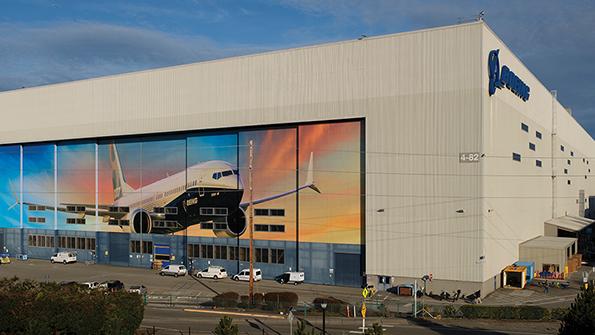4月はボーイングにとって「今のところ」過去最悪の月に

4月はボーイング社にとって最も残酷な月だ。4月6日にワシントン州シアトル近郊の工場は徹底的な消毒・清掃のため無期限の閉鎖となった。これは3月下旬に現地でコロナウィルスによる死者が発生したことを受けた措置で、作業完了後、従業員に職場復帰するよう働きかけている。同日、サウスカロライナ州チャールストンにある同社工場も操業が停止された。
そんな中、ボーイング社では今後一切の職場復帰を望まない従業員がいるかどうか、確認を進めている。
4月2日には希望退職の募集も始めており、同社CEO兼社長・David Calhoun 氏は製品ラインに変更が出る可能性が高いことを認めている。しかしこれらは今回の危機を象徴する出来事ではあるが、最大の問題というわけではない。むしろ、今年を乗り切るための資金繰りが最優先の課題だ。
その規模は、3月にアメリカ議会を通過した数兆ドル規模の景気刺激策および救済法案「CARES法」で明らかになっている。この立法に対し、ボーイング社が自社およびサプライヤー救済のために600億ドルの支援を求めたことは衝撃的だった。
しかし、なぜそうしたのかは簡単に理解できる。短期的なコマーシャルペーパーによる資金調達は、アメリカ、そして世界を突如襲った不況により不可能になったからだ。ボーイング社のCFO(最高財務責任者)・Greg Smith氏は、コマーシャルペーパーへのアクセスが少なくとも一時的には閉ざされたと語った。一方、Calhoun氏は強気の姿勢を見せようとし、150億ドルの現金に加え、96億ドルのクレジットライン(信用与信枠)もあると述べた。
では、なぜボーイング社は政府からの救済を求めるのだろうか?同社は2019年に270億ドルの負債を抱えており、前年比で2倍の赤字となっている。3月中旬にマーケットが停止状態になる前までに、同社は総額140億ドル近いクレジットラインを設定し、その後完全に解除した。同社の民間航空機事業部だけでも、毎月40億ドル以上が自身とSpirit AeroSystems社やGeneral Electric Aviation社といった一部サプライヤーを維持するために費やされている。さらに、エンブラエル社の民間航空機部門の買収で42億ドル、債務返済のために40億ドルといった、巨額の出費も必要だ。アナリストによれば、今年は赤字額がさらに倍増することもあり得る。コロナ危機による遅延で、今年後半までに737MAXの再認証ができなければ、その可能性はさらに高まる。
ボーイング社としては、国からの直接支援や政府による保証の条件として課せられる制約を受けたくはない。Calhoun氏は、アメリカ最大の輸出企業であり、アメリカ第2の防衛大手であるボーイング社の株式を政府に委ねるような考え方は排除しようとした。
しかし、それは「言うは易く行うは難し」というものだ。Aerospace Forumの投資アドバイザーを務め、金融メディアSeeking Alphaではボーイング社に関する分析が注目を集めているDhierin Bechai 氏は「ボーイング社には、政府保証を受ける以外に取れる道はそれほど多くない」と語る。民間航空業界の見通しは、あまりに早く、急激に悪化した。新造された旅客機は保管施設に直接送られる有様だ。民間航空業界の信用市場が充分に回復し、新たな債務を引き受けることができるようになったとしても、ボーイング社はその債務の条件により打撃を受ける可能性がある。「ちょっとした計算をすれば、ボーイング社は数ヶ月程度は耐えられるだろうが、この危機が2020年後半まで続くとしたら、もう持たないことぐらいはすぐ分かる」と、Bechai氏は3月31日に語っている。
しかし、ボーイング社の仕事は少なくなるだろう。近日中に、同社は2020年以降の新しい、より少ない生産計画を発表するとみられている。
アナリスト達は、将来の生産数予測を下方修正している。Vertical Research Partners 社のRob Stallard氏とKarl Oehlschlaeger氏は3月30日に、 向こう5年間の新造旅客機の必要数は6,300機を予想していると語ったが、彼らの以前の予想では8,300機だった。機種別に見ると、ナローボディ機が1,540機減、ワイドボディ機が380機減で、ともに25%ほどの減少となっている。
Jefferies社のアナリストであるSheila Kahyaoglu氏とGreg Konrad氏は3月31日付けの予測で、2020年の航空機納入数は前年比70%減となり、2020~23年の 累積納入数予想も60%減となった。これは、航空会社が所有する多くのワイドボディ機が地上保管され続け、新造機のデリバリーを受け付けないとみられているためだ。
両氏は、ボーイング社は2020年に月産4機の787を製造し、2021~2022年は月産6機に拡大すると予想している。また777Xについては月1機の納入を予想しており、「これは月3機の予想と比べるととても悲観的な見方だ」とも述べている。
同様に、Roland Berger 社のManfred Hader氏とRobert Thomson氏は、2019年の生産規模に戻るには2年を要すると予想している。しかし、737MAXが今のような状況に置かれているため、ボーイング社の回復はより長くかかり、逆にエアバス社はより早く回復するとしている。
ボーイング社とエアバス社にとって、大型民間機の需要は長期にわたって少なくなる…というのが、コロナ危機後の「ニュー・ノーマル」だ。すでに737MAXにより劣勢に立たされているボーイング社は、同社に大きく投資してくれるアメリカ資本探しに必死になるかもしれない…それがたとえ政府であっても。
以上は、Michael BrunoがAviation Week & Space Technologyに書いた記事。Aviation Week NetworkのAviation Week & Space Technologyに書をもっと知りたい場合、こちらをクリックして下さい。
April is the cruelest month for Boeing. As of April 6, the aerospace and defense giant’s Puget Sound, Washington, sites were closed indefinitely for deep cleaning, and Boeing is trying to convince workers to come back after at least one local death from the COVID-19 pandemic was reported in late March. That same day, the company announced that work at its factory in Charleston, South Carolina, was suspended, too.
Meanwhile, Boeing is asking if there are some workers who do not want to come back at all.
On April 2, Boeing announced voluntary layoffs, and CEO and President David Calhoun acknowledged there likely will be changes coming to its product lines. But as monumental as those changes might be, they are not the biggest concern. Instead, the OEM first must figure out how to finance itself through the rest of the year.
The numbers were well-publicized in March as the U.S. Congress raced to pass its multitrillion-dollar stimulus and relief bill in response to the coronavirus pandemic, the CARES Act. Jaws dropped when Boeing sought a $60 billion aid package for itself and its suppliers as part of the legislative sausage-making.
But it is easy to see why it did so: Short-term commercial paper financing is frozen as a recession suddenly grips the U.S. and likely the world. Boeing Chief Financial Officer Greg Smith said access had dried up, at least temporarily. Calhoun tried to offer a brave face and said Boeing has access to $15 billion in cash and another $9.6 billion revolving credit line.
So why would Boeing seek government aid? The company ended 2019 with more than $27 billion in debt, doubling the red ink from the year before. By mid-March, before credit markets froze, it had newly opened and then fully drawn down a credit line totaling nearly $14 billion. Boeing Commercial Airplanes alone is burning through more than $4 billion a month to bankroll itself and some suppliers, starting with Spirit AeroSystems and General Electric Aviation, and it faces other big bills such as the $4.2 billion acquisition of most of Embraer’s commercial division and $4 billion in debt repayments. Analysts say Boeing could have to nearly double its debt again this year, especially if the grounded and halted 737 MAX is not recertified until late this year due to further delays caused by the COVID-19 pandemic.
Boeing wants either no strings attached on direct U.S. aid or government guarantees that back its loans from other financiers. Calhoun tried swatting down the idea of giving Washington outright equity in what is the country’s biggest exporter and second-biggest defense prime.
But that is likely easier said than done. “There aren’t many options to explore for Boeing without a guarantee from the government,” says Dhierin Bechai, an investment advisor with the Aerospace Forum whose Boeing analyses are widely followed on Seeking Alpha. The commercial aviation outlook has turned so bad so rapidly that newly minted airliners are being flown to storage. Even if commercial credit markets thaw enough for new debt to be taken on, Boeing could get hammered on the terms of that debt. “Doing the math, you can conclude rather quickly that Boeing can sustain a couple of months, but if this is going to last well into late 2020, then this is not sustainable,” Bechai said March 31.
But there probably will be less work in which to be involved. Any day now, Boeing is expected to announce new, lower production rates for 2020 and perhaps for the longer term.
Analysts are lowering their expectations for future production. Rob Stallard and Karl Oehlschlaeger of Vertical Research Partners on March 30 said they envision a revised requirement for 6,300 new airliners over the next five years, compared with their previous forecast of 8,300. By type, they foresee 1,540 fewer narrowbodies and 380 fewer widebodies, both roughly 25% cuts versus their prior demand model.
Analysts Sheila Kahyaoglu and Greg Konrad of Jefferies on March 31 forecast that aircraft deliveries will fall about 70% year-over-year in 2020, and they reduced their 2020-23 cumulative delivery estimate by around 60%, as airlines continue to defer deliveries with a significant portion of the widebody fleet parked.
The Jefferies duo assume Boeing will produce its 787 widebody at an average rate of four a month this year, stepping up to six in 2021 and 2022. They also forecast 777X deliveries at a rate of one per month, “which is quite pessimistic relative to [an] assumption of three a month.”
Similarly, Manfred Hader and Robert Thomson of Roland Berger say a recovery to overall 2019 production rates will take two years, albeit faster for Airbus and longer for Boeing, given the MAX situation.
The new normal for Boeing (and Airbus) is lower for longer when it comes to large commercial aircraft demand. With the MAX already putting it behind, Boeing may become eager for any American to boost his or her stake in the company, even Uncle Sam.